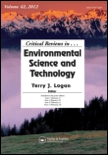
CRITICAL REVIEWS IN ENVIRONMENTAL SCIENCE AND TECHNOLOGY
Scope & Guideline
Driving Excellence in Environmental Research and Technology
Introduction
Aims and Scopes
- Environmental Contaminants:
The journal focuses on the occurrence, fate, and impact of various environmental contaminants, including microplastics, heavy metals, pharmaceuticals, and personal care products, providing insights into their ecological and human health risks. - Innovative Remediation Technologies:
CREST publishes reviews on advanced technologies for pollution remediation, including bioremediation, photocatalysis, and electrochemical methods, highlighting their effectiveness, challenges, and environmental implications. - Ecotoxicology and Risk Assessment:
The journal emphasizes research on ecotoxicological assessments of pollutants, exploring their effects on biota and ecosystems, and promoting methodologies for environmental risk assessment. - Sustainable Practices and Policies:
CREST addresses sustainable practices in environmental management, promoting policies and frameworks that integrate scientific findings into practical applications for environmental protection and resource recovery. - Interdisciplinary Approaches:
The journal encourages interdisciplinary research that combines environmental science with engineering, public health, and policy studies, fostering a holistic understanding of environmental challenges.
Trending and Emerging
- Microplastics Research:
There is a growing emphasis on the sources, impacts, and remediation of microplastics, reflecting heightened public and scientific concern over plastic pollution and its effects on ecosystems and human health. - Antibiotic Resistance and Environmental Health:
Recent articles highlight the relationship between environmental contaminants and the emergence of antibiotic resistance, underscoring the need for integrated approaches to manage public health risks associated with environmental exposure. - Advanced Material Applications:
The use of engineered nanomaterials and other advanced materials in environmental applications, such as pollutant removal and resource recovery, is increasingly prominent, showcasing innovations in environmental technology. - Machine Learning and Data-Driven Approaches:
There is an emerging trend towards utilizing machine learning and data analytics in environmental research for predictive modeling, monitoring pollutant behavior, and optimizing remediation strategies. - Holistic Environmental Management:
A trend towards holistic approaches that integrate ecological, economic, and social dimensions of environmental management is evident, reflecting a shift towards sustainable and multifaceted solutions to environmental issues.
Declining or Waning
- Traditional Pollutant Remediation:
Research on conventional remediation techniques, such as chemical treatments and physical removal methods, has seen a decline as newer, more innovative approaches gain traction, particularly those that leverage biological processes or advanced nanomaterials. - Historical Contaminant Studies:
There is a noticeable decrease in reviews focusing solely on historical pollutants and their effects, as the journal shifts towards addressing emerging contaminants and contemporary environmental challenges. - Single-Factor Environmental Studies:
Research that examines single pollutants in isolation is becoming less common, as interdisciplinary approaches that consider the interactions of multiple contaminants and their collective effects on ecosystems gain importance.
Similar Journals
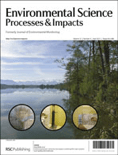
Environmental Science-Processes & Impacts
Empowering voices in environmental science and policy.Environmental Science-Processes & Impacts is a premier journal published by the Royal Society of Chemistry, focusing on critical research in the field of environmental science. With ISSN 2050-7887 and E-ISSN 2050-7895, this journal has established itself as an authoritative source of knowledge since its inception in 2012, maintaining a remarkable Q1 quartile ranking across significant categories such as Environmental Chemistry, Management, Monitoring, Policy and Law, Medicine, and Public Health for the year 2023. It stands as an essential resource for professionals, researchers, and students, aimed at advancing scientific understanding and solutions to pressing environmental issues. With impressive ranks in Scopus, including #45 in Public Health and #27 in Environmental Chemistry, the journal provides a platform for impactful research and interdisciplinary collaboration, emphasizing open access to foster the dissemination of knowledge globally. Join a community committed to exploring the interconnectedness of environmental processes and their implications for society by contributing to or learning from cutting-edge studies published in this esteemed journal.

Soil and Water Research
Pioneering Research at the Intersection of Soil and WaterSoil and Water Research, an esteemed journal published by the Czech Academy Agricultural Sciences, is dedicated to advancing the fields of Aquatic Science and Soil Science. With a strong commitment to open access since 2006, this journal facilitates the dissemination of high-quality research and fosters global collaboration among researchers, professionals, and students. Operating from the vibrant academic hub of Prague, Czech Republic, it serves as a key resource for those interested in pressing environmental and agricultural challenges. Featuring a robust H-index and ranking in the Q2 category for both Aquatic Science and Soil Science as of 2023, Soil and Water Research occupies a prominent position in Scopus, ensuring that published works reach a wide audience. The journal invites contributions that explore innovative methodologies and provide insights into soil and water management practices, thus playing a critical role in addressing sustainability issues within these interconnected domains. As researchers navigate the complexities of climate change and resource management, Soil and Water Research stands out as a vital tool for informed decision-making and impactful research.
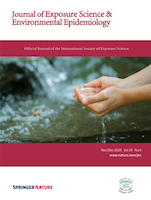
Journal of Exposure Science and Environmental Epidemiology
Empowering Research for a Healthier PlanetJournal of Exposure Science and Environmental Epidemiology, published by SPRINGERNATURE in the United Kingdom, is a leading platform for researchers and practitioners dedicated to understanding the interplay between environmental factors and human health. With an impressive impact factor and Q1 and Q2 rankings across multiple categories such as Pollution and Public Health, the journal has established itself as a critical resource in the fields of epidemiology, toxicology, and environmental science. Covering a wide spectrum of studies from 2006 to 2024, it aims to disseminate timely research that empowers professionals and informs policy decisions. Although there is no open access option at this time, the journal's rigorous peer-review process ensures that only high-quality research is published, further cementing its reputation as a vital source of knowledge for advancing public health and environmental protection.
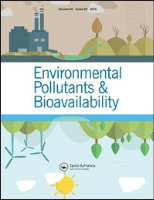
Environmental Pollutants and Bioavailability
Connecting Science to Public Health InitiativesEnvironmental Pollutants and Bioavailability, published by Taylor & Francis Ltd, serves as a critical platform for disseminating high-quality research focused on the interactions between environmental contaminants and biological systems. Since its inception as an Open Access journal in 2019, it has rapidly gained recognition within the scientific community, achieving a commendable Q2 ranking in multiple categories including Chemical Health and Safety, Health, Toxicology and Mutagenesis, and Toxicology for the year 2023. The journal aims to bridge the gap between environmental science and public health by exploring innovative methodologies, risk assessments, and bioavailability studies related to pollutants. Located in the United Kingdom, Environmental Pollutants and Bioavailability is positioned to impact ongoing discourse and research practices in the fields of toxicology and environmental safety, making it an invaluable resource for researchers, professionals, and students dedicated to advancing knowledge in these critical areas.
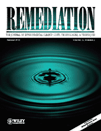
Remediation-The Journal of Environmental Cleanup Costs Technologies & Techniques
Advancing Environmental Solutions for a Cleaner TomorrowRemediation: The Journal of Environmental Cleanup Costs Technologies & Techniques is a pivotal publication in the field of environmental engineering, pollution management, and waste disposal. Published by Wiley since 1990, this journal has established itself as a significant resource for researchers and practitioners dedicated to environmental remediation technologies and cost-effective cleanup techniques. With an impressive scope that spans over three decades and continues to evolve until 2024, the journal is recognized for its valuable contributions, reflected in its Q2 ranking in key categories such as Environmental Engineering, Pollution, and Waste Management and Disposal. Although not currently open access, it offers critical insights and scholarly articles that adhere to rigorous peer-review standards, making it a leading forum for sharing innovative research and practical applications aimed at addressing environmental cleanup challenges. Positioned within the competitive landscape of Scopus rankings, it attracts attention from a global audience, ensuring that its findings resonate within academic, governmental, and industrial domains. Researchers, professionals, and students alike will find Remediation an indispensable tool for advancing knowledge and fostering collaboration in environmental sustainability.
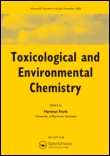
TOXICOLOGICAL AND ENVIRONMENTAL CHEMISTRY
Championing interdisciplinary dialogue for environmental health.TOXICOLOGICAL AND ENVIRONMENTAL CHEMISTRY is a pivotal journal published by Taylor & Francis Ltd, addressing critical intersections between environmental chemistry and toxicology since its inception in 1979. With its ISSN 0277-2248 and E-ISSN 1029-0486, the journal serves as a platform for rigorous research and innovative methodologies in pollution control, health implications of environmental chemicals, and the broader spectrum of toxicological studies. Although it currently does not offer open access, the journal's impact in the field is underscored by its Category Quartiles rankings in 2023, placing it in Q3 across Environmental Chemistry, Health, Toxicology and Mutagenesis, and Pollution categories. Furthermore, its Scopus rankings reveal its significant role within the scientific community, specifically in areas such as Environmental Science and Toxicology. The journal aspires to foster multidisciplinary dialogue and advance knowledge that contributes to environmental sustainability and public health, making it an essential resource for researchers, professionals, and students dedicated to these fields.

Frontiers of Environmental Science & Engineering
Connecting research and practice to shape environmental progress.Frontiers of Environmental Science & Engineering is a premier journal published by HIGHER EDUCATION PRESS that stands at the forefront of interdisciplinary research in environmental science and engineering. Established in 2013 and converging its scope through 2024, this journal has swiftly ascended to a notable Q1 category in the Environmental Science (Miscellaneous) segment, highlighting its remarkable impact and relevance. With a Scopus ranking of 27 out of 233 in its field, placing it within the top 88th percentile, it serves as a crucial platform for disseminating cutting-edge research, innovative methodologies, and pressing environmental concerns. Researchers, professionals, and students alike will find valuable insights and opportunities for collaboration within its pages. While the journal operates under a subscription model, its commitment to advancing the field makes it an essential resource for those dedicated to addressing the world's environmental challenges, fostering sustainable practices, and pioneering engineering solutions.

Environmental Sciences Europe
Leading the charge against pollution through collaboration.Environmental Sciences Europe is a leading peer-reviewed journal published by SPRINGER, dedicated to advancing research in the field of environmental science, with a specific focus on pollution and its mitigation. Since its transition to Open Access in 2011, the journal has been committed to disseminating high-quality research without barriers, thereby ensuring that critical knowledge is freely accessible to researchers, practitioners, and policymakers around the globe. Based in Germany and with a commendable Q1 ranking in Pollution for 2023, the journal stands out in the Scopus rankings, occupying the 23rd position out of 167 in its category, reflecting its significant impact in shaping environmental discourse. With a convergence of global research efforts projected until 2024, Environmental Sciences Europe aims to provide a vital platform for scholarly communication and collaboration, ultimately contributing to sustainable solutions for pressing environmental challenges.
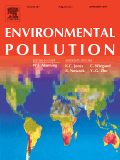
ENVIRONMENTAL POLLUTION
Unveiling the science behind environmental contaminants.Environmental Pollution, published by Elsevier Science Ltd, stands at the forefront of research related to environmental contaminants and their effects on health and ecosystems. With an impressive impact factor reflected in its Q1 rankings across various categories including Health, Toxicology, and Pollution, this journal is a pivotal resource for academics and professionals in the fields of environmental science and toxicology. The journal, established in 1973, continues to disseminate high-quality articles that explore the implications of pollution and advance knowledge on toxicological impacts and mitigation strategies. Although it is not an open-access journal, it offers robust visibility within the scientific community, ensuring vital research reaches those who need it most. Researchers, students, and professionals dedicated to understanding and addressing the challenges of environmental pollution will find Environmental Pollution to be an indispensable platform for their work, guiding the ongoing dialogue on sustainable practices and public health protection.
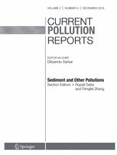
Current Pollution Reports
Transforming Environmental Challenges into SolutionsCurrent Pollution Reports, published by Springer Heidelberg, is an esteemed journal in the field of environmental science, focusing on the multifaceted aspects of pollution, waste management, and water science. With an impressive 2023 impact factor reflected in its status as a Q1 journal across multiple categories—including Management, Monitoring, Policy and Law, Pollution, Waste Management and Disposal, and Water Science and Technology—this journal stands at the forefront of environmental research and policy discourse. The journal, which has been in publication since 2015, aims to provide a platform for scholars and practitioners to share their findings, promoting the exchange of innovative ideas and effective solutions to pressing environmental challenges. With its rigorous peer-review process, Current Pollution Reports serves as an invaluable resource for researchers, professionals, and students committed to understanding and addressing pollution and its impacts on our planet.